You don’t need fields to farm. In fact, there are many items you can grow in a bucket, allowing access to fresh farm food no matter where you live.
Container gardening has taken the world by storm. Increased populations mean less land, and abundant farming soils have developed into concrete urban jungles.
Despite this drastic change of scenery, you can still grow healthy fruits and vegetables even in an apartment.
Aside from the changing landscape around us, the weather also affects our access to fresh food. Those in colder climates pay a premium for fresh fruits and vegetables shipped to local grocery stores.
Unfortunately, growing many plants outdoors is not an option for these people due to harsh, cold climates.
Thankfully, many foods we grow in our garden can also be grown indoors. While you probably don’t have a greenhouse in your backyard or on your balcony, chances are you can find a bucket, and that is all you need to start farming fresh food at home.
25 Crops You Can Grow In Buckets All Year Round
Many plants can be grown at home, no matter where you are located. Indoor gardens eliminate the harsh effects of the outdoor climate and allow access to fresh foods.
Creating an indoor container garden or hybrid garden is easy. All it takes is a little effort and knowledge about which plants grow best inside. Below are some plants that you can grow indoors and in containers year-round.
Tomatoes
 Tomatoes grow surprisingly well indoors. Since most tomato plants must be sprouted inside, keeping them indoors is convenient.
Tomatoes grow surprisingly well indoors. Since most tomato plants must be sprouted inside, keeping them indoors is convenient.
Tomatoes can be planted inside at any time of year. To extend the growing season of indoor tomatoes, plant them in September.
Kale
Kale thrives in cooler weather, making it the perfect option for container gardening. This plant does well outdoors when planted in spring and fall and is best planted indoors at the beginning of summer.
Peppers
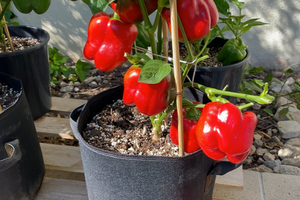 When placed indoors, peppers can be grown year-round. Planting peppers in a portable bucket allows you to move them around to aid with lower sunlight during winter months.
When placed indoors, peppers can be grown year-round. Planting peppers in a portable bucket allows you to move them around to aid with lower sunlight during winter months.
Related: How to Can Simple Tomato Sauce from Fresh Tomatoes and Peppers
Arugula
You can grow arugula indoors and enjoy salad greens all year long. This plant needs 10-12 hours of sunlight, should be placed at a south-facing window if possible, and should be planted 3 inches apart.
Eggplant
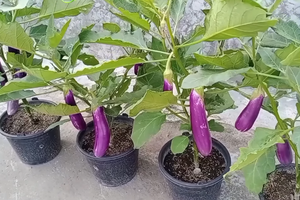 Eggplant is relatively easy to grow and does well in a container garden.
Eggplant is relatively easy to grow and does well in a container garden.
Eggplants are also a plant that continually reproduces, so you get a lot of vegetables in a little space. Since eggplants are tropical plants, you may require a heat lamp or grow light for maintenance.
Herbs
Growing herbs is easy and can save you a lot of money. Fresh herbs are more fragrant and often preferable to dried varieties. Herbs also offer a simplistic introduction to edible gardening for beginners.
⇒ Click Here To Get The 10 Medicinal Herbs You Need To Have In A Crisis
Most herbs can be grown in containers in your home, but basil, chives, mint, oregano, parsley, rosemary, and thyme tend to be the easiest to maintain and fair the best when planted inside.
Onions
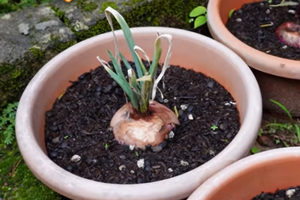 Onions are another plant that is relatively easy to grow indoors.
Onions are another plant that is relatively easy to grow indoors.
Ensuring they have enough space is the most crucial aspect of maintaining this plant.
Six inches of depth and three inches between each plant is best.
Depending on the type, onions also require 12-16 hours of sunlight daily. Thus, a grow light may help produce an optimal environment.
Cucumbers
Cucumbers do well indoors in a deep, hanging basket or large container. Provide the plant with at least 8 hours of sun each day and harvest when the plant reaches 10 inches in height.
Carrots
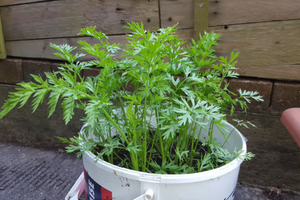 Outdoor carrots are best harvested in the fall or spring.
Outdoor carrots are best harvested in the fall or spring.
However, to keep carrots growing year-round, plant them indoors when winter begins and spring is coming to an end.
If you plant the carrot seeds bi-weekly, they will sprout all year.
Lettuce
You can easily grow lettuce at home and access healthy greens anytime. Lettuce can be grown in almost any container as long as there is sufficient drainage.
An easy-going, low-maintenance plant, lettuce requires very little attention and will grow in most types of soil as long as it is kept moist.
Beans
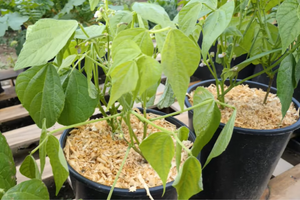 Beans make a great container plant.
Beans make a great container plant.
They take up little space and grow well in most areas. When growing beans indoors, it is essential to ensure they get a good amount of sun.
Related: How to Dry Can Beans and Rice for 20+ Years Shelf Life
Green Onions
One of the easiest ways to grow green onions is with a leftover onion. To do this, submerge the roots in a container of water, changing the water weekly. Once the roots reach five inches, you can move the plant to a pot of soil.
Mint
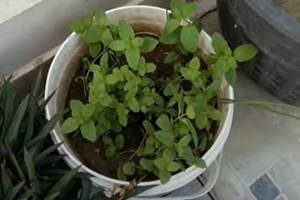 Outside, mint will grow like wildfire, and it smells incredible in the yard.
Outside, mint will grow like wildfire, and it smells incredible in the yard.
However, you can also grow mint in a container inside your house.
Mint needs to receive 4-6 hours of sun per day and has to be shielded from the hot afternoon sunlight.
Mushrooms
Mushrooms are pretty easy to grow. However, they must be placed in a cool, dark, damp space to thrive. Typically a basement, unused cabinet, or closet will work well.
Potatoes
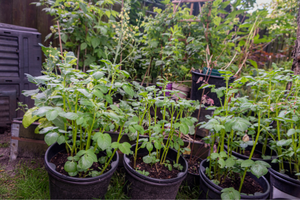 To grow potatoes inside, cut a sprouted potato into two-inch pieces, and plant it in a container of soil that has a 2.5-gallon capacity.
To grow potatoes inside, cut a sprouted potato into two-inch pieces, and plant it in a container of soil that has a 2.5-gallon capacity.
Potatoes grow anywhere and can be an excellent food source.
Related: How To Can Potatoes
Spinach
Spinach is super healthy and easy enough to grow indoors. Plant soaked and softened seeds in a container that receives ample sunlight and keep the soil moist to benefit from this powerful vegetable all year round.
Peas
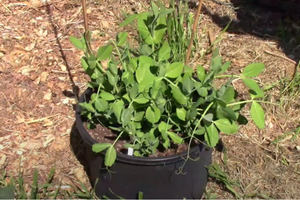 Wide varieties of peas grow well indoors, with snap peas and snow peas being the easiest to grow inside. Peas need sunlight, so they should be placed in the sunniest location of the home.
Wide varieties of peas grow well indoors, with snap peas and snow peas being the easiest to grow inside. Peas need sunlight, so they should be placed in the sunniest location of the home.
Sprouts and plants also require support. Adding a small stick to each shoot will allow them to climb and grow.
Garlic
A life without garlic is no life at all. Thankfully garlic is easy to grow, and you can do it indoors anytime. To grow garlic, place 3-4 cloves in a pot of soil and sit it on a sunny window ledge. Water the plant lightly when dry and allow it to flourish.
Cabbage
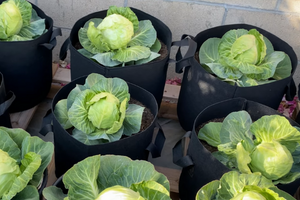 Cabbage typically grows in the fall and spring. Due to its extended growing time, cabbage does well in various temperatures.
Cabbage typically grows in the fall and spring. Due to its extended growing time, cabbage does well in various temperatures.
When growing cabbage indoors, it is best to start the seeds toward the end of spring, but you can space out planting to extend the harvest.
Artichoke
Artichokes require more attention than other plants but can thrive in containers with adequate care.
Related: 11 Fast Growing Vegetables to Grow in a Crisis
The main thing to remember is that proper draining is essential, and the container must be big enough to support its extensive root system. A 5-gallon bucket will work fine for this purpose.
Squash
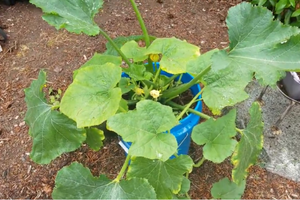 Another plant that is generally straightforward is squash. When planted in a large container with plenty of sunlight, squash can thrive indoors. It is best to choose a smaller, bush-type squash to save space, but squash plants of any type will yield a substantial harvest within about 60 days of planting.
Another plant that is generally straightforward is squash. When planted in a large container with plenty of sunlight, squash can thrive indoors. It is best to choose a smaller, bush-type squash to save space, but squash plants of any type will yield a substantial harvest within about 60 days of planting.
Radishes
Radishes have a shallow root system, making them perfect for indoor gardens. This plant also prefers when it is cool, so spring and early fall are the best times to plant. Alternatively, place the container in an area that suits the optimal conditions, and you can have radishes all year long.
Celery
 You can regrow celery using the base of a used stalk by placing it in a shallow container with water.
You can regrow celery using the base of a used stalk by placing it in a shallow container with water.
It takes about a week to see progress, and then you can move the celery to a container filled with soil.
Related: How To Protect Your Garden From Looting Intruders
Red Beets
Beets do well in containers but require 6-8 hours of sunlight. Place the container in front of a large, sunny window or purchase a grow light if you live in a dark, northern area.
Microgreens
Growing microgreens is increasingly popular, and many systems on the market make the process simple. The main issue with microgreens is that they often do not regrow.
Due to the micro size, all the energy they hold is used in production, and once trimmed, they must be replanted. Still, they are an excellent food source that can be grown year-round.
Although living on a farm may appeal to you, it is not always possible. However, that does not mean you can not live a sustainable, self-sufficient lifestyle wherever you are in the world.
You can grow food inside your home to provide sustenance and security. The list above is not comprehensive, and I would love to hear what you grow in containers at home.
You may also like:
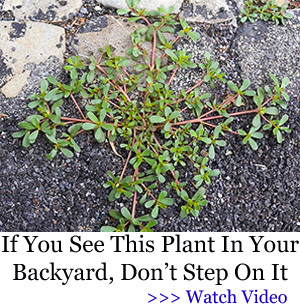 16 Items FEMA Tells You to Stockpile and Why
16 Items FEMA Tells You to Stockpile and Why
How To Build A Hidden Food Growing Fence In Your Backyard (Video)
The Most Powerful Non-Lethal Weapon Against Invading Rioters

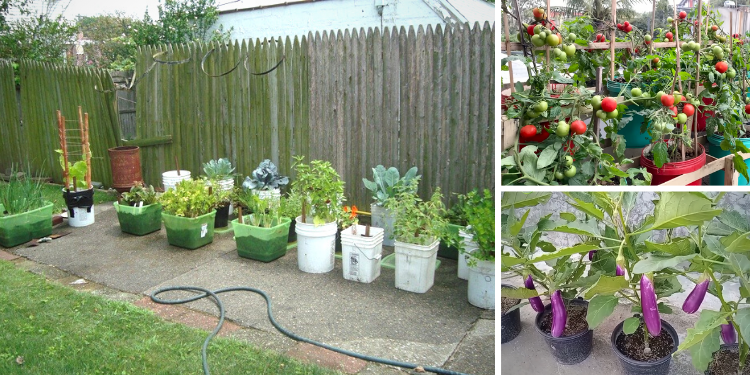




















I think the one item this article doesn’t mention (unless I missed it) – is that you need a south-facing porch/patio/greenhouse room so that the plants can get the amount of light they need to grow. Most people (I venture) don’t have that – leaving them SOL.
I accidently thumbed down sorry about that. Not letting me change it. You mentioned a south facing porch or window…but there is something you haven’t considered which is artificial sunlight through grow lights can provide the needed sunlight each day. I’m using grow lights to grow in a spare bedroom. Just something for you to consider.
Most of my indoor garden either faces east or west. If I leave my plants in the south facing window my cats will eat them.
I have raspberries growing in the east. In the west window I’ve got: red/yellow/black cherry tomatoes, peppers – hot and mild, bell peppers have not come up yet, blueberries, spaghetti squash, green beans and pinto beans.
Unfortunately, my starfruit, dragonfruit and blackberries have yet to come up.
Don’t forget to mix in coffee grounds and crushed eggshells with the dirt/potting soil.
I think, due to the photos, that this article is promoting growing plants in buckets OUTSIDE. you can START them inside when it’s too cold, but then put them outside to continue growing and get pollinated.
Plants crave. Electrolytes it’s what they need.
Go away, I’m BAITIN’!
Not sure
I have been growing those plants in containers for a # of years now, and I start them in the winter in my house! Then I just pick up the pots and take them out side when it gets warm and no chance of frost. And if you do not have a south sun light just use grow lights. I do have a south facing window for my plants but I did buy some grow lights just in case there is too many cloudy days which the chem-trails are producing a lot more here!!!
what is the pest issue like indoors? Don’t want to wake up to a tomato worm on my pillow
White flies, aphids, and fungus gnats. If you have an oscillating fan, set it back from the plants on a low setting. That usually cures white flies and aphids. A vacuum hose is used in fields to control most bugs.niio
Good article, but you forgot to mention one VERY Important fact Kathy.
Unless you’re going to have a Bee Hive in your home, you must pollinate those fruits & veggies that are not self-pollinating.
The first time I grew tomatoes indoors I had 6 very healthy plants and only got 2 tomatoes.
When flowers appear, get a new, soft make-up brush and start tickling the flowers, “Every Single One Of Them”! And do it whenever you see new flowers. The next year when I did this, I had a bumper crop of tomatoes.
An electric toothbrush minus the brush works best. Just touch the stem right above the blossom, tickle until you see the pollen drop.
need to know the male , female family of plants and use manual polination , you polinate
crsto: sounds like an instruction manual, Pimping for Plants. niio
I dunno…sounds like pimpin’ to me…
I think, due to the photos, that this article is promoting growing plants in buckets OUTSIDE. you can START them inside when it’s too cold, but then put them outside to continue growing and get pollinated.
Here in the high plains desert of Wyoming container farming is the only way to go. The results have been fantastic. I found a business that gives me all the containers I need for free. I highly recommend for almost any fruit or vegetable, even dwarf fruit trees. I built a small greenhouse to help extend my growing season and protect crops from hail and high winds so common here.
May I ask what kind of business and what kind of containers? Thanks!
Try a bakery. You need food grade containers and bakeries have frosting containers that come in 5gal buckets.
I have a bay leaf plant growing in my home year round. It is in a south facing window. I also have rosemary growing and i grow tiny tim tomatoes year round. I use grow lights with them. I use a brush to do the pollinating. I have grown hot peppers in the past as well as different herbs. I keep a celery plant growing too. Basil grows great, so does parsley. I do give my plants some liquid fish fertilizer every now and then, they like that. I do broccoli sprouts all winter on my kitchen counter. They are really nutritious. Microgreens are easy to do too. I am going to try some of the ones you have mentioned in the article. Thanks for all the great information.
Excellant review
The one thing you need in time s survival is time frames
how long to grow each item listed above and which areas in any of the 4 seasons and areas of the globe where this grows
Im in a 4 season area so we get very hot summers, very cold winters and about 3-4 month of each give or take a month
this will be essential in the end times when buying and selling will be controled by the world control system for instituting the false worship society , one religeon , one world, one gov. one evil one to control you
you will need a full education in survival , this is coming soon , if your left behind , then you will need this
all others will be raptured , like a bride , going to the wedding of the savior and his chosen
saved from myself, and the sin that controls my nature .
once a sinner , now a saved one
Read, look, review , check it out , like your looking for Gold , silver or precious stone s of great value
Grace will soon come to an end , and mankind will be let go to serve themselves
This is about Surviving not Scripture,
Good article — but I have to say it: I did this well before it was a “thing,” in a basement apartment. One caveat: If you have cats, build a good tight screen around your plants. I think y’ all can figure out why!
I live in South Florida and like to plant veggies in pots around my pool. It gets so hot I have to water sometimes twice a day, but they still get too hot. What can you suggest?
I suggest you plant them in the ground. Or get bigger pots.
Burlap shade cloth during the hottest hours helps.
Use electrolytes
The sun reflection from the pool might be part of the problem. Set them back from the edge of the pool. Any concrete or pool decking will reflect heat and light rays as well. Use some landscape cloth under the containers and extend it 3-4 feet beyond the containers will help reduce this reflection and heat. (Landscape cloth is typically used under gravel/rock landscaping.)
Maybe self pollinating gmo seeds will grow without bees and other insects but would you want to eat that? Better than starving i guess. However, strong uv is non existent in winter. A South facing window may give you a mini harvest but I would recommend a jackery solar power bank. You can run led grow lights with it and supplement the low light. Helluva Lotta work for a couple of tomatoes but again..better than starving.
Shade the pots! They build up heat and can cook roots. I live in southern Arizona and that works here. Also, if you can, all pots should go on the south side, where they get winter sun and summer shade. niio
Red, you are right about soil temps. I am in Colorado, near Denver, and I have the same issue. I try to grow tomatoes in pots on the patio and I have to either put them up against the east side of the house or string up some shade cloth. I am using pots I built out of scrap 2X6. They are 20 in tall and 24 in diameter. That’s plenty of soil for a plant but still not enough to stop the whole thing from overheating in a full days direct sun. I get better results in a raised bed than I do in the pots but I keep trying. Guess I just like the challenge.
Most blooms never see a bee, but are pollinated by flies and so on. If you can, get a hive of trigonas honey bees (better have a greenhouse to keep them happy, tho) They have no stingers and make some of the best, highest quality honey. But, they can’t stand temps below 70 F. niio
Articles like this drive me a crazy. There are millions of “new” gardeners that will take this at face value without the consideration of pollination. It’s basic information, so it should not be assumed that the audience is anything but a beginner.
(My eldest spent a decent amount of money trying hydroponics. Nothing he read told him his tomatoes and cucumbers would need to be hand-pollinated, it was a lot of work & money for very little output.)
He failed to do proper research. Your local extension service can steer you in the right direction.
Will this be successful in central Florida?
No hurricanes
Next time grocery shopping, pick up a bunch of scallions, green onions. Be sure some roots are attached. On getting them home, soak in water about 15 minutes, then divide and plant a few inches apart in good soil. Using scissors, we then cut low, half an inch or so, to the soil. Old-fashioned varieties like Tohono I’itoi will divide as many as 50 times. Scallions from the store should survive 4-10 cuttings. Greens are dehydrated and stored for future use. niio
WOW Please forgive me, I hadn’t actually read the post before I commented that it was about growing outside.
Just went straight to the comments!!! So sorry!
but the photos DO show being grown outside!
I’m blessed with a couple neighbors with huge cattle mineral tubs and have gave me quite a few. They are food grade and my youngest sister didnt belive I knew what I was talking about. She called the feed store, who assured her they were indeed food grade. I picked up 8 just last week. Now to start filling them with composting materials. Then in spring I can add fresh planting soil. I rent and the soil here is mostly clay. There is well water for plants and animals but not humans I have rural water inside the house.
You might be able to check with your local feed stores and see if they can tell you who buys the tubs of minerals.
They are close to 50gallons in size.
Oklahoma was extremely dry this year but I did have a lot of fresh fruit and vegetables from my tubs.
Yeah, well, all that’s good, but you should have discussed the light problem, and the mold problem, and the insect problem associated with indoor gardening. Insecticides inside a closed home in the winter is not a great idea
I don’t use insecticides indoors or outdoors. A moderate spraying of water that contains a few drops of liquid dish soap will handle the aphids and white flies that seem to be the biggest problem. An inexpensive spray bottle works just fine. Grown lights and gentle fan speed to circulate the air handles the other issues.
I have been “container gardening” for a few years, all outside year-round because I live in Zone 10A. These are the fruits and vegetables I grow in containers, to include various sizes of pots both round and rectangular, grow bags, and 5-gallon buckets:
Fruits: grapes, sunflowers, blackberries, raspberries, pineapple, guava, fig, apple, pear, dragon fruit, avocado, mango, lemon, orange, and calamondin. I use sturdy stakes for support, and heavy gauge tomato cages as trellis’ when needed.
Vegetables: potatoes, sweet potatoes, camote, tomatoes, bell peppers, eggplant, garlic, green onions, red onions, white onions, carrots, bush and pole beans, yard-long beans, tepary beans, black-eyed peas, green peas, peanuts, spinach, pak choy, sweet corn, bitter melon, kabocha squash, and zucchini. I use heavy gauge tomato cages as trellis’ when needed.
Herbs: mint, chives, oregano, basil, parsley, sage, rosemary, and thyme.
Gardenate
sssssssss
Thank you.